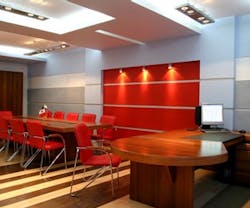Measuring the Green Impact of a Lighting Upgrade
You are probably well-versed in analyzing the financial impact and cost benefits of lighting upgrades. You’re good at presenting these numbers to clients, citing payback periods and ROI, and even sophisticated measures, such as internal rates of return and net present value. Entire lighting upgrade proposals are routinely designed around the attractive financial opportunities that upgrades can deliver, and the significant boost they can add to the client’s bottom line. But what about the all-important environmental benefits of a lighting upgrade? Imagine how compelling it would be to be able to measure and share, in very quantifiable terms, the green contribution that a facility’s lighting upgrade is making to the environment.
The adverse effects of current levels of electricity use on the environment are staggering. Recent statistics from the U.S. DOE’s Energy Information Administration reveal that 2.5 billion tons of pollutants, including sulfur dioxide (SO2), nitrogen oxide (NOx), and carbon dioxide (CO2), are emitted every year as a byproduct of electricity generation by utility companies. Over time, emission has waged profound negative effects on the environment, contributing to the depletion of the ozone layer, increased levels of acid rain, and the heightened prevalence of cardiac and respiratory ailments.
Lighting upgrades, however – involving energy-efficient lamps, ballasts, and lighting controls – make great strides toward offsetting these adverse effects on the environment and reducing ecological footprint. By using the formulas below, derived from a 2009 energy savings calculator developed by the EPA and DOE, you can build this critical element into lighting upgrade proposals you develop for your clients – identifying the green aspect of the project, or the CO2 reduction and air pollution reduction equivalence (in terms of acres of trees planted and cars removed from U.S. roads) the lighting upgrade is driving. Provision of this kind of environmental data will help you deliver greater informational value and raise awareness of this important (but often overlooked) lighting upgrade benefit.
The Calculation Tool
Though originally calculated based on the environmental benefits associated with conversion of one conventional, less-efficient lamp to an ENERGY STAR-rated compact fluorescent lamp (CFL), the following formulas have been broadened to now apply to any lighting upgrade project involving any lighting technology:
Air Pollution Reduction Delivered by a Lighting Upgrade*:
Pounds of CO2 emission avoided over life of the new lamp**: 15.4 pounds/Watt saved
Equivalent number of cars removed from U.S. roads annually: 0.0013/Watt saved
Equivalent number of acres of trees planted: 0.0015/Watt saved
*Extrapolated from 2009 EPA/DOE energy savings calculator based on the benefits of conversion to a CFL
**Based on estimated 8,000- to 10,000-hour lamp life
Let’s look at the following lighting upgrade scenarios, for example, to demonstrate the use of these formulas:
Example #1: Retail Store
Old technology: 40-Watt halogen PARs
New technology: 11-Watt LED PARs
Watts saved per fixture: 29
Number of fixtures: 50
Benefit in terms of pounds of CO2 emission avoided over the life of the new lamps*:
15.4 pounds x 29 Watts saved/fixture x 50 fixtures = 22,330 pounds of CO2
Benefit in terms of equivalent number of cars removed from U.S. roads annually:
0.0013/Watt saved x 29 Watts saved/fixture x 50 fixtures = 1.9 cars removed annually
Benefit in terms of equivalent number of acres of trees planted:
0.0015/Watt saved x 29 Watts saved/fixture x 50 fixtures = 2.2 acres of trees planted
*Life estimated at 8,000 to 10,000 hours, so environmental benefits may be even greater if lamp lifespan is longer
Example #2: Commercial Building
Old technology: 40-Watt T12 lamps with magnetic ballasts
New technology: Energy-saving 25-Watt T8 lamps with electronic ballasts
Watts saved per fixture: 15 (simple calculation without additional savings from ballast)
Number of fixtures: 10,000
Benefit in terms of pounds of CO2 emission avoided over the life of the new lamps*:
15.4 pounds x 15 Watts saved/fixture x 10,000 fixtures = 2.31 million pounds of CO2
Benefit in terms of equivalent number of cars removed from U.S. roads annually:
0.0013/Watt saved x 15 Watts saved/fixture x 10,000 fixtures = 195 cars removed annually
Benefit in terms of equivalent number of acres of trees planted:
0.0015/Watt saved x 15 Watts saved/fixture x 10,000 fixtures = 225 acres of trees planted
*Life estimated at 8,000 to 10,000 hours, so environmental benefits may be even greater if lamp lifespan is longer
As the examples show, a lighting upgrade of any size can have a beneficial effect on the environment; lighting proposals can now be enhanced to demonstrate the measurable green contribution associated with a facility’s lighting upgrade.
Deliver Green Value
On top of their attractive financial benefits, energy-efficient lighting upgrades within the country’s 5 million commercial, industrial, and institutional buildings do more than reduce energy costs, improve productivity, and enhance system quality … they also significantly benefit the environment and help conserve precious natural resources. So don’t hesitate to include an assessment of the green element in your analysis of a lighting upgrade using the simple guidelines above … it will not only enhance the quality of your proposals, but will help your client understand how their actions are driving a more energy-efficient future.
Susan Bloom is a freelancer and consultant, and an 18-year veteran of the lighting and electrical products industry.
